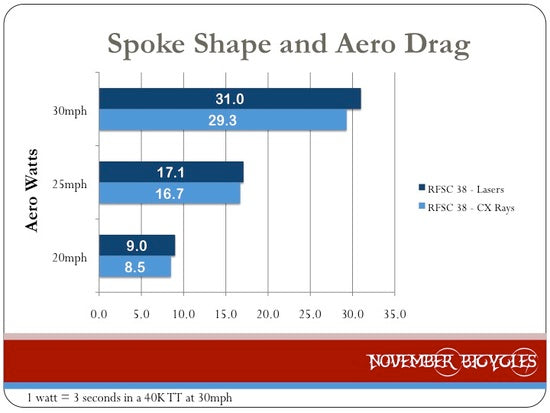One of the things we've learned is that offering choices invites questions. One we get all the time is the difference between Sapim Lasers and CX-Rays, which we offer in all our wheels. Or rather, the question really is whether CX-Rays are worth the extra money.
The answer we've always provided is that the spokes are the same weight but CX-Rays are purported to have some aerodynamic advantage. If you're looking for "every last watt of speed," they're the way to go. But we have never seen anything that quantifies the difference between the two in a wheelset. So we decided test Lasers against CX-Rays in the tunnel to give a more informed and specific response than "every last watt of speed."
It turns out, however, that we've been exactly right all along.
We sent two RFSC 38 (38mm) wheels to the wind tunnel, one built with 20 radial laced Sapim Lasers and the other with 20 radial laced Sapim CX-Rays. Here is how the wheels tested against a range of Angles of Attack (AOA):
At all AOAs, the wheel with the CX-Rays was a smidge faster, generating about 11 fewer grams of drag on average at 30mph. If you recall the calculations from yesterday's blog, you'll see that 11 grams of drag at 30mph is - yep - 1 aero watt. You really do save "every last watt of speed" with CX-Rays, and not a watt more.
You remember also from yesterday that aerodynamic impact is diminished at lower speeds. Here is the difference in aero watts between the Laser and CX-Ray wheels at 30mph, 25mph and 20mph. In these calculations, the average drag is calibarated by the frequency of different AOAs at different speeds, which is why at 30mph the difference between the two wheels is 1.8 watts instead of 1.
Most brands assume that if you're spending between $1K and $3K for a carbon wheelset, you're after that every last watt of speed and they make CX-Rays or other bladed spokes standard. The logic starts to break down with shallower alloys though, where the upgrade to CX-Ray spokes may net you a watt, but still leave you a handful or two behind your training buddy on deep carbon, or oblivious if you're training on your own. For alloys in particular, we think it makes a lot of sense to offer the choice so people are not paying for performance they don't need.



21 comments
http://sheldonbrown.com/rinard/aero/aerodynamics.htm
Thanks for taking the time to share your test information. One critique: Was the power required to spin the wheels during testing measured? From the analysis produced by ZIPP in the past it appears that the energy required to spin your tested wheels may be 0-5 watts of difference. For reference:http://www.aeroweenie.com/assets/backup/zipp_data/spokecount.pdf
Yancey raises an important question. The difference in power required to spin the wheels may be more significant than the measured difference in direct aerodynamic drag of the two wheels. If you could measure this and report it as well you would then have a complete view of the benefit of one type of spoke over the other.
Just revisiting this for a new topic and may as well address the power-to-spin question. We've also seen/read well-supported information from Dr Andrew Coggan on power to spin. He finds that an aero wheel take approximately 3 watts to spin and a non-aero wheel takes 5 watts to spin. We can make some inferences there. If the savings from non-aero to aero is 2 watts in power to spin, and given the behavior that different rims – controlled for spokes – show in wind tunnel tests, we can guess that the difference in power to spin between a CX Ray and a Laser is well under 1 watt. Another point worth re-making is that "bladed spoke" is often used as a blanket to over them all. Not all bladed spokes are created equal.
Try this: Wash your mouth out with water from your water bottle and spit it out…11 grams saved! You can also get a slightly stiffer wheel with a round spoke, but nobody's measured the watt savings there. And when a bladed spoke twists, it breaks providing a nice DNF. For road riders, it's probably a wash unless you're a TDF contender with a weight limit (domestiques probably wouldn't care, they're in the peloton). For those heavy road riders tired of DNFs or just training, try 28 spokes on the rear, the watt difference is still pretty small on a super strong ENVE 45 classic rear wheel, and you'll never DNF again! also, I wouldn't sweat any of this unless you already wear an aero helmet and aero jersey.Ok, I hear you TT guys sighing in the back row, so yeah, go for it on your 90s and skin suits…